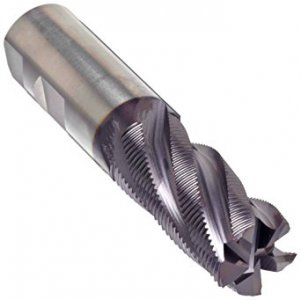-
Welcome back Guest! Did you know you can mentor other members here at H-M? If not, please check out our Relaunch of Hobby Machinist Mentoring Program!
You are using an out of date browser. It may not display this or other websites correctly.
You should upgrade or use an alternative browser.
You should upgrade or use an alternative browser.
Roughing end mills
- Thread starter gonzo
- Start date
- Joined
- Oct 16, 2017
- Messages
- 5
By taking smaller bites, the pressures and forces are smaller thus allowing for a faster material removal rate even on smaller, less rigid machines. Vibrations and resonances are almost eliminated. I can easily double the feedrate by going with the rougher in the mill-drill!
Roughing endmills cut the chips smaller, making chip evacuation easier - critical on slotting and pocketing.
Each 'tooth' tip penetrates the material easier than the entire edge of a standard endmill. As slamadeleine indicated, roughers/corncobs cut easier than do standard endmills.
The surface speed (RPM) of the rougher is the same as for a conventional (given the same tool material/coating), but a greater chip thickness can be taken before running out of spindle horsepower. And greater chip thickness at same RPM means faster speed of advance (travel IPM). And the lower horsepower requirement means a greater DOC can be taken vs. a conventional endmill.
But they leave a not-so-smooth surface finish.
Each 'tooth' tip penetrates the material easier than the entire edge of a standard endmill. As slamadeleine indicated, roughers/corncobs cut easier than do standard endmills.
The surface speed (RPM) of the rougher is the same as for a conventional (given the same tool material/coating), but a greater chip thickness can be taken before running out of spindle horsepower. And greater chip thickness at same RPM means faster speed of advance (travel IPM). And the lower horsepower requirement means a greater DOC can be taken vs. a conventional endmill.
But they leave a not-so-smooth surface finish.
- Joined
- Oct 21, 2017
- Messages
- 504
Great for taking big bites out of the side of chunks of stainless ;-)
- Joined
- Dec 20, 2012
- Messages
- 9,422
O.K. I'll bite.
What advantage if any has a roughing end mill over a plain one?
Until i receive an answer I am guessing that the roughing one removes material faster but I can't figure out how.
Roughing end mills do remove metal faster than standard end mills do. The way they do it is by having numerous teeth ground across the axis of each flute, and each tooth is a separate cutting edge that takes a chip out of the material being cut.

These small chips pass into a relatively huge gullet between the flutes, thereby clearing the teeth to continue cutting. In contrast, each flute of a standard end mill must take a comparatively huge cut and chip clearance is less efficient. Another way to look at this is that each flute of a rougher takes many small bites to produce short, fat chips instead of one big bite with long chips. The result of this is that cutting forces are lower, chip clearance is better and the power required to take many small bites is about 20% less than taking big ones.
Cutting speeds tend to be about 20% faster when using a rougher, while feeds are about the same. What this means is that more metal is removed at higher speeds and typically you can take heavier cuts with a rougher vs a finishing end mill.
Normally, a rougher is used to bulk out a cut and a finishing end mill is used to remove the serrated marks left by the rougher. Doing this greatly extends the useful life of your finishing end mills. You will also find that roughers have a very good service life, much longer than if you were to make the same cuts with a finishing end mill.
There are tons of different roughers and it can be confusing - coarse pitch, fine pitch, sinusoidal, helical, 3 flute, 4/6 flute, etc. As a generalization, coarse pitch roughers work better for slotting (bigger chips, better chip clearance), while fine pitch roughers work better for profiling cuts (smaller chips that are easily thrown clear of the cut). For materials with high ductility, like aluminum, 3 flute helical coarse pitch roughers work well (again, this configuration helps clear chips quickly).
You will find that roughers create tons of tiny chips. This is especially an issue when slotting because as the chips pile up there is more re-cutting by each tooth and this leads to wear. Air or flood cooling is the best way to reduce this re-cutting thing.
Bottom line: buy roughers and learn to use them. They will increase productivity and increase the life of your finishing end mills.
I'll add this: if you have a hobby-size mill and you've not used a rougher before, invest in a set of good bellow covers for your ways. One of the places these companies like to save money is on way protection. The tiny chips produced by roughers are great at finding the gap in your slideways and locking them up. Ask me how I know!

